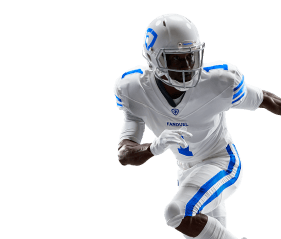U.S. Open: PGA Best Bets, Predictions, Past Results, and Course Info

The U.S. Open -- the third men's golf major of 2025 -- is finally here, and the United States' national open is again headed to Oakmont Country Club.
This is one of the toughest tests in all of golf, and carnage is nearly assured.
Here's all you need to know.
All golf odds come from FanDuel Sportsbook and may change after this article is published.
U.S. Open Info
Oakmont Country Club Course Info
Data from GCSAA, PGA Tour, and data golf's course table unless otherwise noted.
- Par: 70
- Distance: 7,372 yards (long)
- Average Fairway Width: 28 yards (tight)
- Average Green Size: 8,500 square feet (large)
- Green Type: Poa
- Stimpmeter: 14.5 to 15 (lightning fast)
- Recent Winning Scores (U.S. Opens): -6, -10, -6, -6, -6
- Recent Cut Lines (U.S. Opens): +5, +2, +3, +4, +4
- Recent Winning Scores (U.S. Opens at Oakmont): -4 in 2016, +5 in 2007
- Recent Cut Lines (U.S. Opens at Oakmont): +6 in 2016, +10 in 2007
Oakmont Country Club Course Key Stats
- Total Strokes Gained
- Strokes Gained: Approach
- Strokes Gained: Off the Tee
- Emphasis on Driving Distance
- Strokes Gained: Around the Green
- Strokes Gained: Putting
One of the toughest tests in all of golf, Oakmont requires a bit of everything.
Let's start with the overall length: at 7,372 yards, it's quite long for a par 70, and from a hole-by-hole breakdown, there just isn't a lot of reprieve.
Three par 4s are under 400 yards (the 346-yard 2nd, the 379-yard 14th, and the 312-yard 17th). Those three and the short 182-yard par 3 13th were the only holes to play under par in 2016.
Conversely, there are some monster holes, namely the 289-yard par 3 8th, which wasn't even the hardest hole in 2016 (that was the 482-yard par 4 opener!).
Tight fairways with penalizing rough awaits everyone when greens are missed.
Although the greens are about as large as we'll see at any pro course, they're lightning fast. Yes, that impacts putts of all lengths -- but also chips and approaches onto the greens.
There are 168 bunkers at Oakmont, 50 more than at Pebble Beach for a number we just never really see.
The five-inch rough? Also most in my course database. Winged Foot measured at 4.25 in 2020's U.S. Open, and that's the second-longest rough in my database. In 2020, Winged Foot had the 10th-most penalizing rough among 40 courses played, per datagolf, and this week's rough is substantially longer.
You'll need to do everything well, and there's no way around that.
U.S. Open Past Results
For a deeper dive into past U.S. Open history, check out our U.S. Open history breakdown.
U.S. Open Best Bets
These picks stand out relative to their FanDuel Sportsbook golf betting odds at FanDuel Sportsbook. All stats cited below originate at datagolf and reference ranks relative to the field over the past 50 rounds unless otherwise noted.
Jon Rahm
- Odds To Win U.S. Open (+1200)
Jon Rahm's major struggles seem to be a thing of the past, and he's now headed to the U.S. Open, where he's played stellar golf in each of his last five starts.
Since 2019, Rahm has gained strokes in 19 of 20 possible categories at U.S. Opens, only losing marginal strokes around the green at the 2020 U.S. Open at Winged Foot. He's also picked up distance in all five and fairways on the field simultaneously in three of the five.
Back to his major form: this year, Rahm has finished T14 at Augusta National and T8 at the PGA Championship (though was playing aggressively down the stretch in that one).
His ball-striking is pure right now, and one of the things that separated Rahm from other studs at his peak was how good his short game was -- and still is.
Even with large greens, golfers will need to have soft hands around the greens when they inevitably miss, and Rahm's putter can certainly heat up enough for par saves and birdies whenever they're available based on his long-term putting splits.
Xander Schauffele
- Odds To Win U.S. Open (+2200)
Schauffele has been a stud at U.S. Opens, never finishing worse than T14 in any of his eight starts. Overall, he has been the second-best U.S. Open player over the last five years.
Xander is also tied for the best overall major form over the last two years, too. He's tied with Scottie Scheffler at +3.16 strokes gained per round in that span.
If ball speed winds up being vital (as a means to hack it out of the thick rough), Schauffele has that covered, as he's 12th on Tour this season in that metric.
I reject the idea that Schauffele hasn't shown much in 2025. While it's true he has just one top-10 finish (T8 at the Masters), he's been a positive in all three tee-to-green stats and is just neutral (-0.04 per round) with the putter this calendar year.
While this likely isn't the week where we'll see lots of birdies fall, it's also worth noting that Xander is a 54th-percentile putter from within 15 feet on Tour this season -- but only 6th-percentile from beyond that. Better putting days are ahead for one of the game's best long-term putters.
Sepp Straka
- To Finish Top 10 (+360)
Sepp Straka is one of the best iron players in the field (3rd over the last 50 rounds) and also one of the best putters (12th). He's got a recent win under his belt (the Truist Championship on the other side of Pennsylvania) and a 3rd at the Memorial.
He did miss the cut at the PGA and the Masters so far this year but actually striped the irons (as usual) at Augusta and drove and putted well at the PGA.
While it's true that Straka doesn't have the most decorated U.S. Open history, he's averaging 1.30 more shots per round in 2025 than in any other year of his career so far.
Straka should be able to hit fairways (11th in accuracy the last 50 rounds) and play well from fairway through green from there.
Joaquin Niemann
- Top South American (-140)
The 26-year-old Chilean enters the U.S. Open on a run as hot as just about anyone in golf. He has four wins on the LIV Tour since February and has finished T29 at the Masters and T8 at the PGA Championship, two of his best finishes at majors ever.
Niemann has averaged +1.90 true strokes gained per round over his last 50 globally, per datagolf. He's in a four-golfer group with Emiliano Grillo (+400), Jhonattan Vegas (+450), and Nico Echavarria (+500). Those three have 50-round strokes gained averages of +0.20, +0.07, and +0.03, respectively.
This is certainly an interesting way to get access to Niemann, who is +3000 to win outright and -310 to make the cut. My model is seeing value at -140.
Min Woo Lee
- Top Australian (+330)
Min Woo Lee owns the the second-best ball-speed on Tour this year, and that’ll come in handy while playing from thick rough this week.
Min Woo is also quietly a good U.S. Open player in his career, having finished T27, T5, and T21 over the last three years. In those starts, he's gained distance and accuracy off the tee in all three.
Interestingly, Lee's putter is pretty cold right now, but the underlying data looks promising for a turnaround. Lee is an 87th-percentile putter this year from within 15 feet but a 33rd-percentile putter from beyond that.
He’s also the best player in this region over everyone’s last 50 rounds, and the wedge play for Dr. Chipinski should help him get around Oakmont when he inevitably gets into trouble.
Get a No Sweat Bet to use on a “First Round Leader” wager on the U.S. Open Golf Tournament! See here for full terms and conditions. Learn about today’s other offers at FanDuel Sportsbook Promos.
Looking for more golf betting opportunities? Check out all the golf odds and markets at FanDuel Sportsbook.
Sign up for FanDuel Sportsbook and FanDuel Daily Fantasy today!
The above author is a FanDuel employee and is not eligible to compete in public daily fantasy contests or place sports betting wagers on FanDuel. The advice provided by the author does not necessarily represent the views of FanDuel. Taking the author's advice will not guarantee a successful outcome. You should use your own judgment when participating in daily fantasy contests or placing sports wagers.



